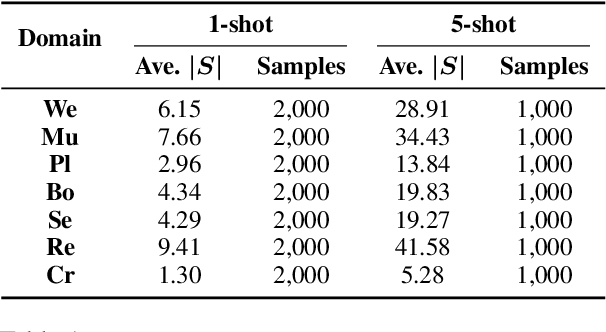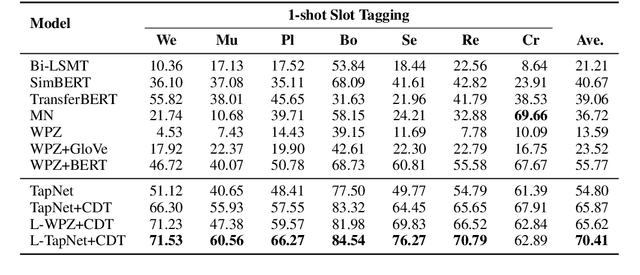Yongkui Lai
Few-shot Learning for Multi-label Intent Detection
Oct 11, 2020



Abstract:In this paper, we study the few-shot multi-label classification for user intent detection. For multi-label intent detection, state-of-the-art work estimates label-instance relevance scores and uses a threshold to select multiple associated intent labels. To determine appropriate thresholds with only a few examples, we first learn universal thresholding experience on data-rich domains, and then adapt the thresholds to certain few-shot domains with a calibration based on nonparametric learning. For better calculation of label-instance relevance score, we introduce label name embedding as anchor points in representation space, which refines representations of different classes to be well-separated from each other. Experiments on two datasets show that the proposed model significantly outperforms strong baselines in both one-shot and five-shot settings.
FewJoint: A Few-shot Learning Benchmark for Joint Language Understanding
Sep 17, 2020



Abstract:Few-learn learning (FSL) is one of the key future steps in machine learning and has raised a lot of attention. However, in contrast to the rapid development in other domains, such as Computer Vision, the progress of FSL in Nature Language Processing (NLP) is much slower. One of the key reasons for this is the lacking of public benchmarks. NLP FSL researches always report new results on their own constructed few-shot datasets, which is pretty inefficient in results comparison and thus impedes cumulative progress. In this paper, we present FewJoint, a novel Few-Shot Learning benchmark for NLP. Different from most NLP FSL research that only focus on simple N-classification problems, our benchmark introduces few-shot joint dialogue language understanding, which additionally covers the structure prediction and multi-task reliance problems. This allows our benchmark to reflect the real-word NLP complexity beyond simple N-classification. Our benchmark is used in the few-shot learning contest of SMP2020-ECDT task-1. We also provide a compatible FSL platform to ease experiment set-up.
Few-shot Slot Tagging with Collapsed Dependency Transfer and Label-enhanced Task-adaptive Projection Network
Jun 10, 2020



Abstract:In this paper, we explore the slot tagging with only a few labeled support sentences (a.k.a. few-shot). Few-shot slot tagging faces a unique challenge compared to the other few-shot classification problems as it calls for modeling the dependencies between labels. But it is hard to apply previously learned label dependencies to an unseen domain, due to the discrepancy of label sets. To tackle this, we introduce a collapsed dependency transfer mechanism into the conditional random field (CRF) to transfer abstract label dependency patterns as transition scores. In the few-shot setting, the emission score of CRF can be calculated as a word's similarity to the representation of each label. To calculate such similarity, we propose a Label-enhanced Task-Adaptive Projection Network (L-TapNet) based on the state-of-the-art few-shot classification model -- TapNet, by leveraging label name semantics in representing labels. Experimental results show that our model significantly outperforms the strongest few-shot learning baseline by 14.64 F1 scores in the one-shot setting.
 Add to Chrome
Add to Chrome Add to Firefox
Add to Firefox Add to Edge
Add to Edge